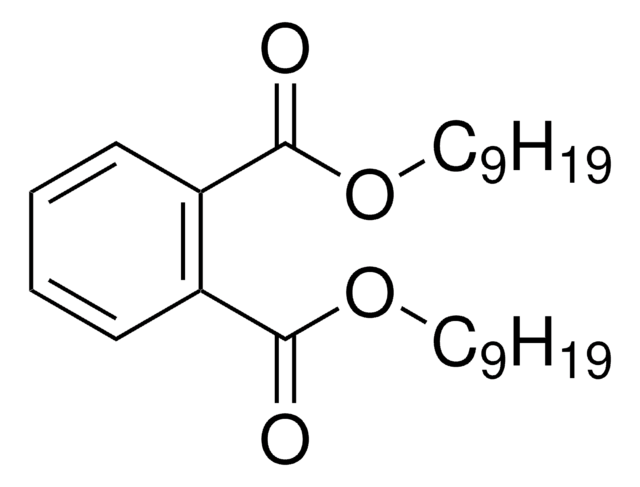36736
Dibutyl phthalate
PESTANAL®, analytical standard
Synonym(s):
n-Butyl phthalate, DBP, Phthalic acid dibutyl ester
About This Item
Recommended Products
grade
analytical standard
Quality Level
vapor density
9.6 (vs air)
vapor pressure
1 mmHg ( 147 °C)
product line
PESTANAL®
assay
≥98%
autoignition temp.
756 °F
shelf life
limited shelf life, expiry date on the label
expl. lim.
0.47 %, 236 °F
technique(s)
HPLC: suitable
gas chromatography (GC): suitable
refractive index
n20/D 1.492 (lit.)
bp
340 °C (lit.)
mp
−35 °C (lit.)
density
1.043 g/mL at 25 °C (lit.)
application(s)
agriculture
cleaning products
cosmetics
environmental
food and beverages
personal care
format
neat
SMILES string
CCCCOC(=O)c1ccccc1C(=O)OCCCC
InChI
1S/C16H22O4/c1-3-5-11-19-15(17)13-9-7-8-10-14(13)16(18)20-12-6-4-2/h7-10H,3-6,11-12H2,1-2H3
InChI key
DOIRQSBPFJWKBE-UHFFFAOYSA-N
Looking for similar products? Visit Product Comparison Guide
General description
Application
Legal Information
signalword
Danger
hcodes
Hazard Classifications
Aquatic Acute 1 - Aquatic Chronic 2 - Repr. 1B
Storage Class
6.1C - Combustible acute toxic Cat.3 / toxic compounds or compounds which causing chronic effects
wgk_germany
WGK 3
flash_point_f
367.7 °F - open cup
flash_point_c
186.5 °C - open cup
ppe
Eyeshields, Gloves, type ABEK (EN14387) respirator filter
Choose from one of the most recent versions:
Certificates of Analysis (COA)
Don't see the Right Version?
If you require a particular version, you can look up a specific certificate by the Lot or Batch number.
Already Own This Product?
Find documentation for the products that you have recently purchased in the Document Library.
Customers Also Viewed
Articles
A sensitive, quantitative, and reproducible SPME-GC/MS procedure was developed by Supelco for the extraction of phthalate esters from oily food matrices, such as the flavored oils included with ramen noodle kits.
Our team of scientists has experience in all areas of research including Life Science, Material Science, Chemical Synthesis, Chromatography, Analytical and many others.
Contact Technical Service







